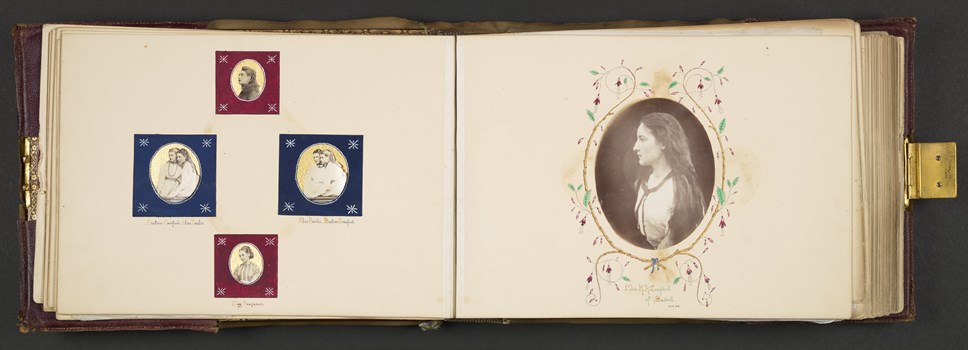
100 years of Scottish photography secured for the nation
An exceptional collection of historic photographs that captures a century of life in Scotland is to be shared with the public following a special collaboration between the National Library of Scotland and the National Galleries of Scotland.
More than 14,000 images – dating from the earliest days of photography in the 1840s through to the 1940s – have been jointly acquired with support from the Scottish Government, the Heritage Lottery Fund and the Art Fund.
The collection covers an expansive range of subjects – including family portraits, working life, street scenes, sporting pursuits, shops, trams, tenements, mountains and monuments. Until now, it was one of the last great collections of Scottish photography still in private hands.
The collection was put together by photography enthusiast Murray MacKinnon, who established a successful chain of film-processing stores in the 1980s, starting from his pharmacy in Dyce, near Aberdeen.
He said: “The collection covers the day-to-day lives of Scottish people both rich and poor, the work they carried out including fishing and farming, in order to survive, and their social life including sport and leisure. These were turbulent times what with industrialisation, shipbuilding, new forms of transport, the social upheaval caused by the First World War in Europe and the Boer War in South Africa. The discovery of penicillin and radiography heralded the development of medicine and the pharmaceutical industry in Scotland.
“I would like to thank all the people involved in acquiring this collection for the Scottish nation, and for their great efforts in making this acquisition possible.”
Culture Secretary Fiona Hyslop welcomed the public acquisition.
She said “The MacKinnon collection is one of the most remarkable collections of Scottish photography and an invaluable resource for researchers, students and the wider public. I am delighted that £300,000 of Scottish Government funding has supported the acquisition, curation, touring and digitisation of this collection, preventing it from being broken up or sold overseas.
“Our rich cultural and artistic heritage plays an intrinsic part in boosting our economy and tackling inequalities. I commend the National Galleries of Scotland and National Library of Scotland for their achievement in ensuring that this unique collection can now be enjoyed by the people of Scotland, enabling the public to learn more about our fascinating early photography tradition.”
National Librarian, Dr John Scally said: “Scotland has a unique relationship with photography which dates back to the work of the early pioneers such as Hill and Adamson. This acquisition is akin to buying Scotland’s photographic album of 14,000 pictures and bringing it home, and together with the National Galleries of Scotland, we were determined to make that happen. I am confident that every Scot will feel a connection with these wonderful photographs and we look forward to sharing them with the public over the coming months.”
National Galleries of Scotland, Director General Sir John Leighton, said: “This collection superbly demonstrates the important role Scotland had in shaping the history of photography. Our ability to tell this story is greatly enriched by this acquisition, and we look forward to the exciting partnership with the National Library of Scotland in making these artworks accessible to all.”
Heritage Lottery Fund, Manager for Scotland, Lucy Casot, said: “Taken in the pioneering days of photography in Scotland, these historical images allow us to glimpse our ancestors going about their daily lives. Thanks to players of the National Lottery, this valuable resource has been secured for us all to enjoy. It’s a fascinating collection detailing what life was like and how that has shaped us as a nation.”
Director of Art Fund, Stephen Deuchar said: “We are proud to be able to support both National Library of Scotland and National Galleries of Scotland in acquiring Murray MacKinnon’s unparalleled collection for the nation. It is incredible to have these photographs join a public collection where they can be enjoyed for generations to come through their display and tours as well as digitally."
The photographs provide a visual record of how Scotland has changed physically, socially and economically since the 1840s.
Highlights include:
- More than 600 original photographs from the pioneering days of photography featuring work from David Octavius Hill (1802-1870) and Robert Adamson (1821-1848), James Ross (d.1878) and John Thomson (d.1881), Cosmo Innes (1798-1874) and Horatio Ross (1801-1886)
- Some of the finest work of Thomas Annan (1829-1887) and his son, James Craig Annan (1864-1946) including rare examples of their original albumen prints
- Fine examples of the work of Scotland’s successful commercial photographers including George Washington Wilson (1823-1893) and James Valentine (1815-1880)
- Portraits of Scottish regiments from the Crimean War by Roger Fenton (1819-1869)
- A series of albums and prints depicting life in the main towns and cities from the late 1800s and early 1900s
- Studies of farming and fishing communities in remote villages and hamlets
- Scenes of shipbuilding, railways, herring fishing, weaving, whisky distilling, dockyards, slate quarries and other working environments
The collection contains an exquisite view of Loch Katrine by William Henry Fox Talbot, who travelled to Scotland in the autumn of 1844. Talbot was the inventor of the calotype, a negative-positive paper process that was patented around the world, but, importantly not in Scotland, allowing for free use and experimentation. As a result, early Scottish photographers, such as Hill and Adamson and Ross and Thomson, were encouraged to take up the new technology, becoming key figures in developing its potential as both document and art form within its first two decades.
As the photographic medium evolved, Scotland once again was at the forefront when, in 1883, Thomas Annan and his son James Craig Annan secured the British rights for the previously secret process of photogravure. The photomechanical process created prints in large editions, revolutionising the publication and reach of photography.
While photography is known for its reproducibility, many of the artworks contained within the collection are unique, including daguerreotype portraits and hand-made albums. One such impressive example is the Fairlie album, consisting of family portraits and photographs by known makers including Julia Margaret Cameron. Using elements of collage, drawing and marginalia, the pages are a one-of-a-kind celebration of the Fairlie Family, from Fife. Reginald Fairlie was the architect of the National Library of Scotland building on George IV Bridge.
A major exhibition of the MacKinnon collection will be held at the Scottish National Portrait Gallery next year, with touring exhibitions around the country to follow. The entire collection will also be digitised over the next three years and made available online.
#Scotlandsphotos
Contact Information
Notes to editors
The collection was purchased from a private collector, who bought the collection from Murray MacKinnon.
Breakdown of funding for the acquisition:
- Heritage Lottery Fund - £350,000
- Scottish Government - £300,000
- National Library of Scotland - £125,000
- National Galleries of Scotland - £125,000
- Art Fund - £100,000
TOTAL £1 million
The National Library of Scotland
The National Library of Scotland is a major European research library and one of the world’s leading centres for the study of Scotland and the Scots – an information treasure trove for Scotland’s knowledge, history and culture.
The Library’s collections are of world-class importance. Key areas include digital material, rare books, manuscripts, maps, music, moving images, official publications, business information, science and technology, and modern and foreign collections.
The Library holds more than 26 million physical items dating back over 1000 years in addition to a growing library of e-books, e-journals and other digital material. The collection includes more than four million books, eight million manuscripts, two million maps and more than 45,000 films and videos. Every week the Library collects around 5,000 new items. Most of these are received free of charge in terms of Legal Deposit legislation.
www.nls.uk / @natlibscot / facebook
National Galleries of Scotland
The National Galleries of Scotland (NGS) looks after one of the world's finest collections of Western art, ranging from the Middle Ages to the present day, including masterpieces by Titian, Rembrandt, Monet, Van Gogh, Picasso and Magritte. These holdings include the national collection of Scottish art, which is displayed in an international context.
Every year, the NGS welcomes over 2.2 million visitors from Scotland and the rest of the world to our three Galleries in Edinburgh: the Scottish National Gallery, the Scottish National Gallery of Modern Art and the Scottish National Portrait Gallery.
The latter first opened to the public in 1889 as the world’s first purpose-built portrait gallery. Aside from its outstanding collection of paintings, sculptures, prints and drawings, this distinctive red sandstone building also houses the national collection of photography, with some 38,000 historic and modern photographs and film.
Art Fund
Art Fund is the national fundraising charity for art. In the past five years alone Art Fund has given £34 million to help museums and galleries acquire works of art for their collections. It also helps museums share their collections with wider audiences by supporting a range of tours and exhibitions, and makes additional grants to support the training and professional development of curators.
Art Fund is independently funded, with the core of its income provided by 139,000 members who receive the National Art Pass and enjoy free entry to over 320 museums, galleries and historic places across the UK, as well as 50% off entry to major exhibitions and subscription to Art Quarterly magazine. In addition to grant-giving, Art Fund’s support for museums includes Art Fund Museum of the Year (won by The Hepworth Wakefield in 2017) and a range of digital platforms.
Find out more about Art Fund and the National Art Pass at www.artfund.org
Heritage Lottery Fund (HLF)
Thanks to National Lottery players, we invest money to help people across the UK explore, enjoy and protect the heritage they care about – from the archaeology under our feet to the historic parks and buildings we love, from precious memories and collections to rare wildlife. www.hlf.org.uk. Follow us on Twitter, Facebook and Instagram and use #NationalLottery and #HLFsupported. For further information, please contact Katie Owen, HLF Press Office, on tel: 020 7591 6036/07973 613820
